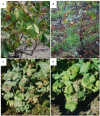Georgian Grapevine Cultivars: Ancient Biodiversity for Future Viticulture
- PMID: 33613611
- PMCID: PMC7892605
- DOI: 10.3389/fpls.2021.630122
Georgian Grapevine Cultivars: Ancient Biodiversity for Future Viticulture
Abstract
Grapevine (Vitis vinifera) is one of the most widely cultivated plant species of agricultural interest, and is extensively appreciated for its fruits and the wines made from its fruits. Considering the high socio-economic impact of the wine sector all over the world, in recent years, there has been an increase in work aiming to investigate the biodiversity of grapevine germplasm available for breeding programs. Various studies have shed light on the genetic diversity characterizing the germplasm from the cradle of V. vinifera domestication in Georgia (South Caucasus). Georgian germplasm is placed in a distinct cluster from the European one and possesses a rich diversity for many different traits, including eno-carpological and phenological traits; resistance to pathogens, such as oomycetes and phytoplasmas; resistance to abiotic stresses, such as sunburn. The aim of this review is to assess the potential of Georgian cultivars as a source of useful traits for breeding programs. The unique genetic and phenotypic aspects of Georgian germplasm were unraveled, to better understand the diversity and quality of the genetic resources available to viticulturists, as valuable resources for the coming climate change scenario.
Keywords: Vitis vinifera L.; climate change; genetic diversity; phenotypical characterization; resistance to diseases.
Copyright © 2021 Sargolzaei, Rustioni, Cola, Ricciardi, Bianco, Maghradze, Failla, Quaglino, Toffolatti and De Lorenzis.
Conflict of interest statement
The authors declare that the research was conducted in the absence of any commercial or financial relationships that could be construed as a potential conflict of interest.
Figures







References
-
- Abashidze E., Mdinaradze I., Chipashvili R., Vashakidze L., Maghradze D., Rustioni L., et al. (2015). Evaluation of eno-carpological traits in Georgian grapevine varieties from Skra germplasm repository. Vitis 54 151–154.
-
- Arnold C., Schnitzler A., Douard A., Peter R., Gillet F. (2005). Is there a future for wild grapevine (Vitis vinifera subsp. silvestris) in the Rhine Valley? Biodivers. Conserv. 14 1507–1523. 10.1007/s10531-004-9789-9 - DOI
Publication types
LinkOut - more resources
Full Text Sources
Other Literature Sources

